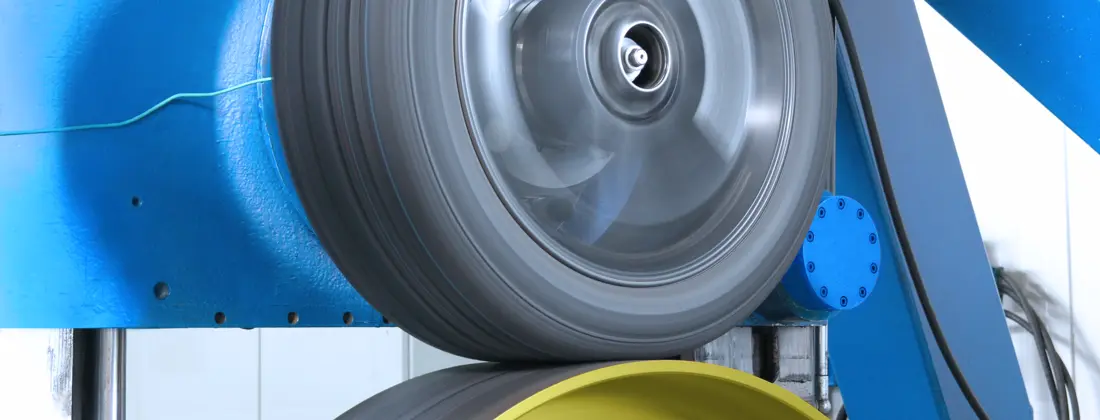JIS D4236 Tyre Bead Unseating Test
The JIS D4236 Tyre Bead Unseating Test is a critical procedure used to evaluate the resistance of tyre beads against the unseating force. This test is essential for ensuring that tyres meet stringent safety requirements and can withstand operational stresses without compromising their integrity.
The test is conducted by placing a tyre on a suitable rim, inflating it to specified pressure levels, and then applying an unseating force to dislodge the bead from the rim. The primary objective is to determine the maximum unseating force required to separate the bead from the rim. This procedure helps in assessing the durability, strength, and reliability of tyre beads.
The test is governed by Japanese Industrial Standard (JIS) D4236. This standard ensures that tyres are manufactured with consistent quality and adhere to safety regulations. The test involves several key steps:
- Specimen Preparation: Tyres are selected for testing based on their intended use, size, and material composition.
- Inflation: The tyre is inflated to the specified pressure using a calibrated pump.
- Application of Force: A unseating force is applied gradually until the bead separates from the rim.
The test results are recorded as the maximum force required for separation. These values are compared against the standard to ensure compliance with JIS D4236.
This testing procedure is particularly important in the automotive sector, where tyre performance directly impacts driving safety and comfort. By adhering to this test, manufacturers can enhance product reliability and meet stringent industry standards. This ensures that tyres perform consistently under various conditions, thereby minimizing risks associated with bead unseating during normal use.
The JIS D4236 Tyre Bead Unseating Test is a cornerstone of tyre quality assurance, providing critical data on the mechanical properties of tyre beads. It supports continuous improvement in manufacturing processes and ensures that tyres meet or exceed safety expectations.
Benefits
The JIS D4236 Tyre Bead Unseating Test offers significant benefits to various stakeholders within the automotive industry:
- Safety Assurance: Ensures that tyres can withstand operational stresses without compromising safety.
- Quality Control: Provides critical data for quality assurance and process improvement.
- Compliance: Helps manufacturers meet stringent industry standards, ensuring compliance with JIS D4236.
- Innovation: Supports the development of new tyre designs and materials by identifying potential weaknesses early in the manufacturing process.
The test is particularly beneficial for quality managers and R&D engineers who need to ensure that their products meet high standards. By incorporating this test into their quality control processes, manufacturers can enhance product reliability and safety.
Compliance officers will find this testing procedure invaluable as it provides clear guidelines on how to assess tyre bead performance. This ensures that all tyres produced are safe and reliable, meeting the highest industry standards.
Customer Impact and Satisfaction
The JIS D4236 Tyre Bead Unseating Test significantly impacts customer satisfaction by ensuring tyre quality and safety. When tyres meet or exceed these stringent standards, customers can trust that their vehicles will perform reliably under various conditions.
This testing procedure enhances customer confidence in the products they purchase, leading to increased customer loyalty and repeat business. By adhering to this test, manufacturers demonstrate a commitment to excellence, which is crucial for building long-term relationships with customers.
The results of the JIS D4236 Tyre Bead Unseating Test are used by quality managers and R&D engineers to improve product design and manufacturing processes. This continuous improvement ensures that tyres meet or exceed customer expectations, enhancing overall satisfaction.
International Acceptance and Recognition
The JIS D4236 Tyre Bead Unseating Test is widely recognized and accepted internationally. It is used by tyre manufacturers to ensure that their products meet the highest standards of quality and safety.
- ISO/IEC: The test aligns with international standards, ensuring compatibility with global manufacturing practices.
- ASTM: It is recognized alongside other industry standards, providing a consistent framework for tyre testing.
- EN: European Norms recognize this procedure as part of their broader quality assurance measures.
The test is also used by regulatory bodies in various countries to ensure that tyres meet safety and performance requirements. This global acceptance enhances the credibility of tyre manufacturers who use this testing method, fostering trust among international consumers.
By adhering to this test, manufacturers can ensure their products are recognized and accepted worldwide, broadening market reach and increasing competitiveness.





